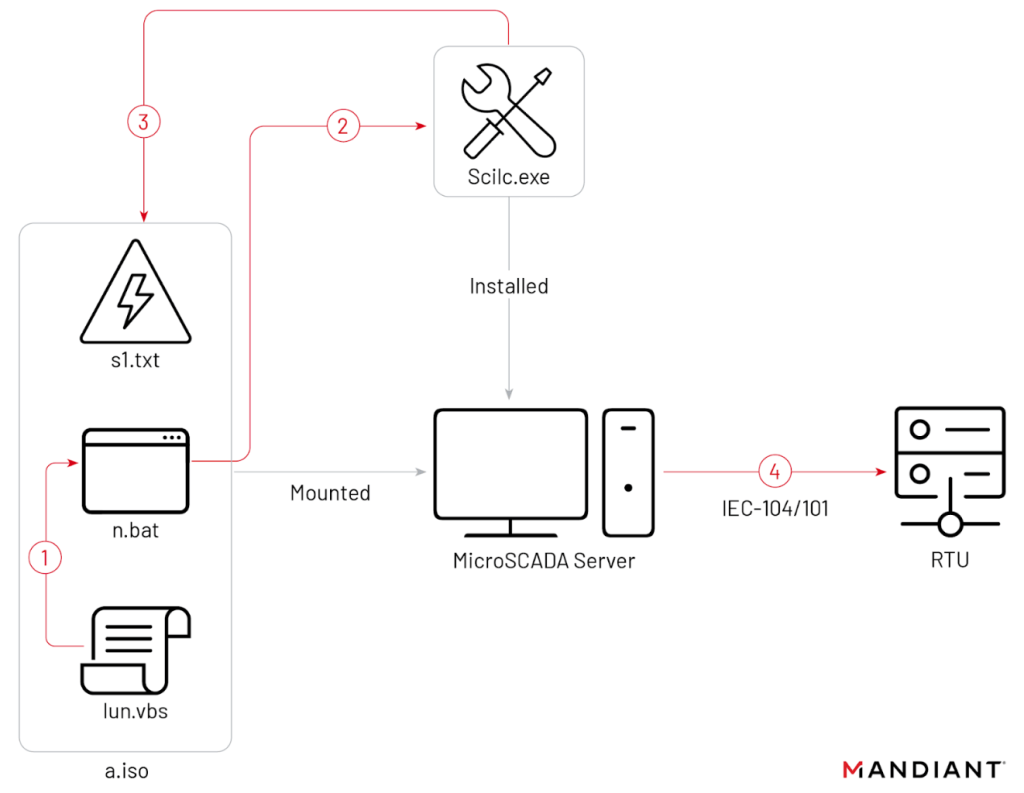
2023-11-10 02:58:11 Author: securityaffairs.com(查看原文) 阅读量:14 收藏
Russian Sandworm disrupts power in Ukraine with a new OT attack
Pierluigi Paganini
November 09, 2023

Mandiant reported that Russia-linked Sandworm APT used a novel OT attack to cause power outages during mass missile strikes on Ukraine.
Mandiant researchers reported that Russia-linked APT group Sandworm employed new operational technology (OT) attacks that caused power outages while the Russian army was conducting mass missile strikes on critical infrastructure in Ukraine in October.
The Sandworm group (aka BlackEnergy, UAC-0082, Iron Viking, Voodoo Bear, and TeleBots) has been active since 2000, it operates under the control of Unit 74455 of the Russian GRU’s Main Center for Special Technologies (GTsST). The group is also the author of the NotPetya ransomware that hit hundreds of companies worldwide in June 2017. In 2022, the Russian APT used multiple wipers in attacks aimed at Ukraine,including AwfulShred, CaddyWiper, HermeticWiper, Industroyer2, IsaacWiper, WhisperGate, Prestige, RansomBoggs, and ZeroWipe.
The nation-state actor first used OT-level living off the land (LotL) techniques to likely trip the victim’s substation circuit breakers, causing an unplanned power outage. Then the APT group deployed a new variant of the CADDYWIPER data wiper in the target’s IT environment to destroy its operations and remove forensic artifacts.
On October 10, the threat actors leveraged an optical disc (ISO) image named “a.iso” to execute a native MicroSCADA binary to issue commands to switch off substations.
Hitachi MicroSCADA is a Supervisory Control and Data Acquisition (SCADA) system developed by Hitachi Energy. It is a software platform that is used to monitor and control industrial and infrastructure systems. MicroSCADA is used in a wide range of industries, including power generation, transmission, and distribution, oil and gas, water and wastewater, and transportation.
The analysis of the timestamp for one of the artifacts (“lun.vbs”) suggests that the attacks began two months before, at the time threat actors gained initial access to the target SCADA system.
The researchers noticed that the wiper deployment only impacted the IT environment of the victim, it did not impact the hypervisor or the SCADA virtual machine. According to Mandiant, this is unusual since the threat actor had removed other forensic artifacts from the SCADA system which would have been enhanced by the wiper activity. A possible explanation for this behavior is the lack of coordination among components of the attack team.
“Sandworm’s substation attack reveals notable insights into Russia’s continued investment in OT-oriented offensive cyber capabilities and overall approach to attacking OT systems. This incident and last year’s INDUSTROYER.V2 incident both show efforts to streamline OT attack capabilities through simplified deployment features.” reads the report published by Mandiant.
“The techniques leveraged during the incident suggest a growing maturity of Russia’s offensive OT arsenal, including an ability to recognize novel OT threat vectors, develop new capabilities, and leverage different types of OT infrastructure to execute attacks. By using LotL techniques, the actor likely decreased the time and resources required to conduct its cyber physical attack.”
Mandiant has yet to determine how Sandworm gained initial access to the target environment. The APT group was first observed in the victim’s environment in June 2022, at the time the attackers deployed the Neo-REGEORG webshell on an internet-facing server. A few weeks later, the nation-state actor deployed the Golang tool GOGETTER to establish a tunnel with the C2 infrastructure.
The experts were unable to identify the SCIL commands executed, however thay believe attackers used commands to open circuit breakers.
“The SCIL commands would have caused the MicroSCADA server to relay the commands to the substation RTUs via either the IEC-60870-5-104 protocol for TCP/IP connections or the IEC-60870-5-101 protocol for serial connections.” continues the report.
The CADDYWIPER variant employed in the attack was compiled in October 2022, it features slight functional enhancements enabling threat actors to dynamically resolve functions at runtime. Mandiant observed the deployment of the CADDYWIPER wiper across various sectors in Ukraine, including government and financial domains, particularly during Russia’s invasion of the country.
The report includes a discovery and hardening guidance, Indicators of Compromise (IoCs) and Yara rules.
In October, researchers reported that the APT Sandworm has hacked eleven telecommunication service providers in Ukraine between May and September 2023.
Follow me on Twitter: @securityaffairs and Facebook and Mastodon
(SecurityAffairs – hacking, Sandworm)
如有侵权请联系:admin#unsafe.sh
